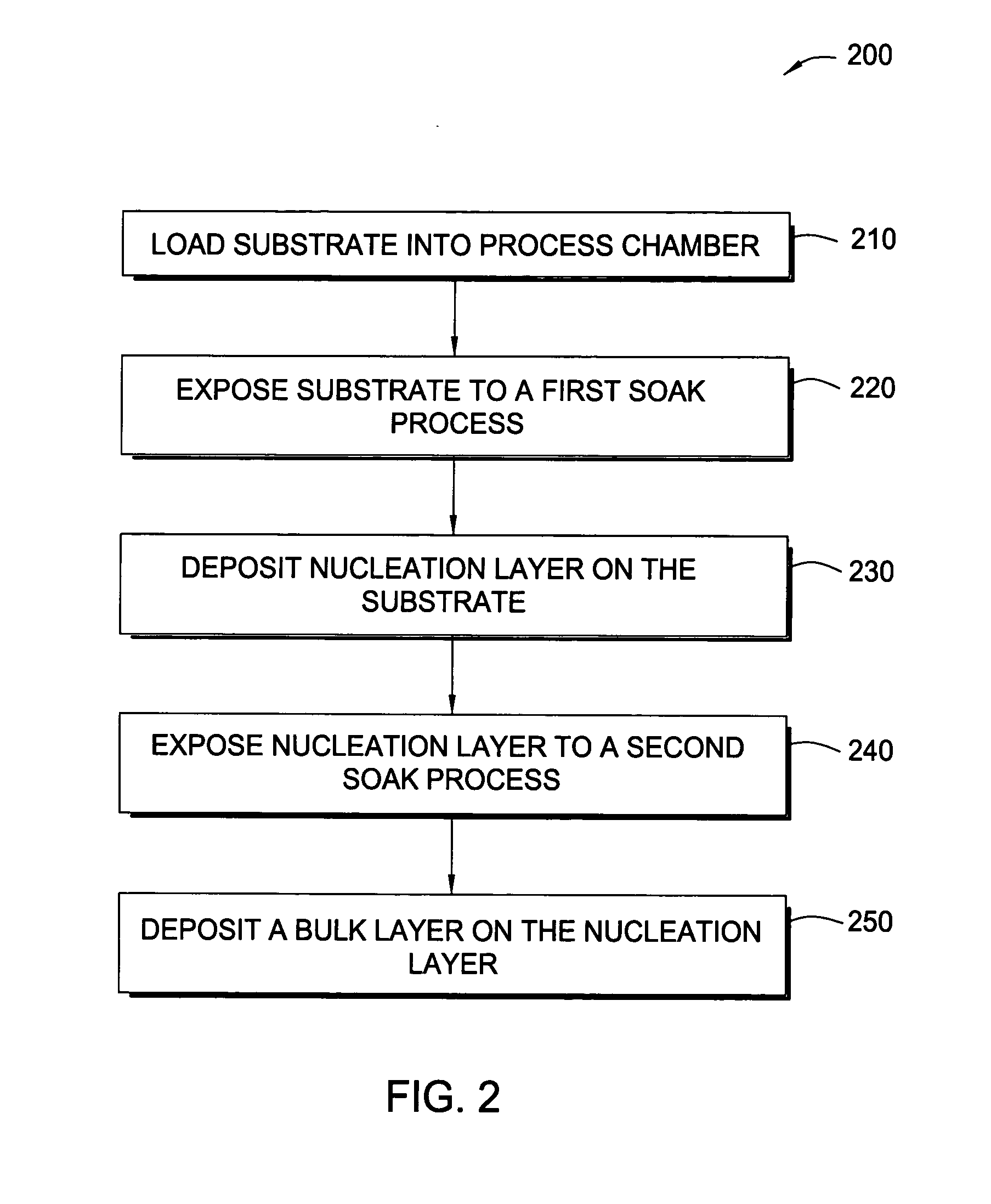Methods for depositing tungsten layers employing atomic layer deposition techniques
a technology of atomic layer deposition and tungsten, which is applied in the direction of chemical vapor deposition coating, solid-state devices, coatings, etc., can solve the problems of compromising the structural and operational integrity of the underlying portions of the integrated circuit being formed, the need for more complexity in the chamber design and gas flow technique, and the conventional cvd method of tungsten depositing
- Summary
- Abstract
- Description
- Claims
- Application Information
AI Technical Summary
Benefits of technology
Problems solved by technology
Method used
Image
Examples
example 1
[0075] The substrate was placed into an ALD chamber and exposed to a soak process under the following conditions: [0076] Reagent: B2H6; [0077] Pressure: about 15 Torr; [0078] Temperature: about 300° C.; [0079] Flow rates: 300 sccm 5% B2H6 in Ar; and [0080] Duration: about 30 seconds.
[0081] Next, a tungsten nucleation layer was formed on the barrier layer in the same ALD chamber from the previous soak process using an ALD process under the following conditions: [0082] Reagents: WF6 and B2H6; [0083] Pressure: about 5 Torr; [0084] Temperature: about 300° C.; [0085] Flow rates: pulse A: 20 sccm WF6 and 300 sccm Ar; [0086] pulse B: 150 sccm B2H6 and 150 sccm H2; [0087] Ar-purge: 500 sccm; [0088] Cycle duration: Ar-purge: 0.5 seconds; [0089] pulse A: 0.2 seconds; [0090] Ar-purge: 0.5 seconds; and [0091] pulse B: 0.2 seconds.
[0092] The cycle was repeated 4 times to form a nucleation layer with a thickness of about 12 Å. Thereafter, the substrate was maintained in the ALD chamber and expo...
example 2
[0099] The substrate was placed into an ALD chamber and exposed to a soak process under the following conditions: [0100] Reagent: B2H6; [0101] Pressure: about 15 Torr; [0102] Temperature: about 300° C.; [0103] Flow rates: 300 sccm 5% B2H6 in Ar; and [0104] Duration: about 30 seconds.
[0105] Next, a tungsten nucleation layer was formed on the barrier layer in the same ALD chamber as used in the prior soak process using an ALD process under the following conditions: [0106] Reagents: WF6 and SiH4; [0107] Pressure: about 10 Torr; [0108] Temperature: about 300° C.; [0109] Flow rates: pulse A: 30 sccm WF6 and 300 sccm Ar; [0110] pulse B: 20 sccm SiH4 and 300 sccm H2; [0111] Ar purge: 500 sccm; [0112] Cycle duration: Ar-purge: 0.5 seconds; [0113] pulse A: 0.3 seconds; [0114] Ar-purge: 0.5 seconds; and [0115] pulse B: 0.3 seconds.
[0116] The cycle was repeated 4 times to form a nucleation layer with a thickness of about 30 Å. Thereafter, the substrate was transferred to a CVD chamber and ex...
example 3
[0123] The substrate was placed into a CVD chamber and exposed to a soak process under the following conditions: [0124] Reagent: B2H6; [0125] Pressure: about 90 Torr; [0126] Temperature: about 400° C.; [0127] Flow rates: 200 sccm 5% B2H6 in Ar; and [0128] Duration: about 24 seconds.
[0129] Next, a tungsten nucleation layer was formed on the barrier layer in the CVD chamber from the previous soak process using a pulsed-CVD process under the following conditions: [0130] Reagents: WF6 and SiH4; [0131] Pressure: about 30 Torr; [0132] Temperature: about 400° C.; [0133] Flow rates: 60 sccm WF6 and 30 sccm SiH4; [0134] Pulse duration: 1.5 seconds; [0135] The pulsed-CVD process was continued until the nucleation layer had a thickness of about 50 Å. Thereafter, the substrate was kept in the CVD chamber and a second nucleation layer was deposited on the first nucleation layer. The second nucleation layer was deposited by a traditional CVD process to a thickness of about 200 Å under the follow...
PUM
| Property | Measurement | Unit |
|---|---|---|
| time | aaaaa | aaaaa |
| temperature | aaaaa | aaaaa |
| time period | aaaaa | aaaaa |
Abstract
Description
Claims
Application Information
 Login to View More
Login to View More - R&D
- Intellectual Property
- Life Sciences
- Materials
- Tech Scout
- Unparalleled Data Quality
- Higher Quality Content
- 60% Fewer Hallucinations
Browse by: Latest US Patents, China's latest patents, Technical Efficacy Thesaurus, Application Domain, Technology Topic, Popular Technical Reports.
© 2025 PatSnap. All rights reserved.Legal|Privacy policy|Modern Slavery Act Transparency Statement|Sitemap|About US| Contact US: help@patsnap.com



